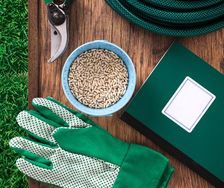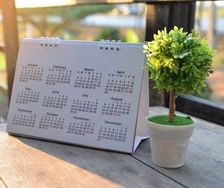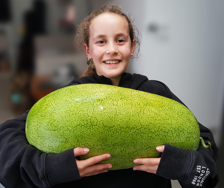Yates Account
Join now
Create a Yates account today!
Sign up to join the Yates Garden Club for monthly e-mails packed with seasonal inspiration, tips for success & exclusive promotions.
Plus if you’re a Garden Club member you can take part in the Yates Growing Community - a blog to share successes, get advice & win prizes in fun challenges along the way!

Forgot password
Enter the email address associated with your account, and we'll email you a new password.
Coleoptera
Heteronychus arator

What are Black Beetles?
The African Black Beetle is an introduced pest species. In NZ it’s mostly found in the upper North Island. Larvae are easily mistaken for NZ grass grubs, although they're a different species to native grass grubs (Costelytra giveni) and bronze beetles (Eucolaspis brunnea).
Damage to garden plants is caused by both the adult beetles and their larvae. Adults mostly feed on plant shoots and stems, just above or below the soil surface (they can burrow as far as 15cm deep). They fly in swarms, most often on warm nights – especially in autumn, less often in spring. Flying beetles are attracted towards artificial lights.
Black beetle larvae feed on grass and plant shoots below soil level, causing dead patches, yellowing and severed stems. Larvae generally cause damage to lawns from summer to early autumn, December - March.
The summer season is the easiest way to diagnose black beetle larvae in a lawn, because the other, similar grub species tend to cause damage from autumn into winter. This summer activity means black beetle is a particular pest of warm season grasses like kikuyu and couch.

Symptoms
Lawns:
- Wilted grass blades - even after regular and deep watering.
- Straw-like leaves.
- Yellowing leaves.
- Severed shoots just above or below the surface of the soil often, with a frayed or 'shredded' appearance.
- Dead or dying patches.
- In patches of turf where roots have been chewed, turf can be easily lifted, similar to rolling back a corner of carpet.
Plants:
- Wilted foliage and young shoots - even after regular and deep watering.
- Stunted growth.
- Reduced plant health.
- Severed shoots just above or below the surface of the soil, often with a frayed or 'shredded' appearance.
- Flattened, toppled or partially uprooted plants.
- Ringbarking of stems at the base of plants.
- Affected seedlings and young plants can be easily lifted from the ground, due to a chewed or poorly developed root system.
- Holes in tubers, e.g. potatoes and kūmara.
- Dead plants.

Plants Impacted
Lawns
Most grass varieties are susceptible to attack, severely impacting lawns and pasture areas. Warm-season lawn types are particularly at risk.
- Kikuyu
- Couch
- Fescues (Tall and Fine)
- Ryegrass
Vegetables
Both potted plants and plants in the ground are at risk. Young plants and seedlings are particularly vulnerable to attack.
- Carrots
- Corn & Maize
- Cauliflower
- Grapevines
- Kūmara
- Potato
- Strawberry
- Tomato
Ornamentals
Ornamental garden plants may also be impacted.
- Begonia
- Calendula
- Marigold
- Petunia
- Protea

Lifecycle
Usually, there is just one generation of African Black Beetle per year. However, depending on environmental conditions, it can take up to 2 years to complete their lifecycle.
- In spring, after mating, the adult female lays eggs just underneath the surface of vegetation. Eggs are small (1.8mm), round and cream-coloured. Females lay between 6 and 12 eggs at a time, laying approximately 30 eggs in her lifetime.
- After 2–5 weeks, eggs hatch and grub-like larvae emerge. Larvae develop through 3 larval stages (instars), shedding their exoskeleton at each stage. After hatching, the first instar feeds on decaying organic matter just above the soil surface. At the second instar larvae burrow into the soil. At the second and third instar stage, larvae feed below ground on plant and grass roots, which is when they do the most damage. Larvae are generally active from summer to early autumn, December - March.
- From late summer to early autumn, mature larvae dig a chamber in the soil to create an ‘earthen cell’. Larvae ‘clear their guts’ of food and become a pale-yellow colour. As pupae develop, they become slightly darker and redder in colour and shorter (15mm long) and more rounded in appearance. During the pupal stage, pupae don't feed, staying inactive while they gradually transform into adults.
- After pupating for about 2 weeks, adults emerge in late summer and autumn. Over winter, adult beetles become less active. In cold conditions, they hibernate in the soil, then emerge in spring fully mature and ready for mating. Adults generally survive for about 10 months, dying soon after reproducing.

How to Identify Adults
Beetles are glossy black, oval-shaped and 12-15mm long. On the underside of the body are light-brown bristle-like structures (setae). The head is short, broad and angles downwards. At the front of the head are chewing mouthparts. On either side of the head are a pair of compound eyes and short, golf-club-like antennae. Behind the head, on the upper side of the body, is a large trapezoid-shaped plate (pronotum) which is the front segment of the middle section of the body (thorax).
Attached to the underside of the thorax are 3 pairs of legs which are lightly covered in spines. The upper portion of the leg is slightly flattened while the lower leg is thinner and thread-like. However, in males, the lower portion of the front legs are also slightly flattened. At the tips of the legs are claws. The hindlegs are the largest pair which are used for digging. Adult beetles are slow crawlers, on the ground.
Adults have 2 pairs of wings, the outermost wings are hardened forewings (elytra) and used to protect the delicate membranous hind-flight-wings. While at rest, forewings fold down over the flattened hindwings and meet in the centre of the body, forming a distinct straight line. At the top of this line is a small triangular-shaped plate known as the scutellum. Along the length of the forewings are straight, mostly parallel indented lines.
How to Identify Larvae
The grub-like larvae have a creamy-white body with an orange-to-brown rounded head capsule, and black jaws. The hind section of the body is generally swollen and grey-blue to green in colour, due to the visible contents of the gut. The body is long and heavily segmented, naturally curls into a C-shape, and grows up to 25mm long. At the front, along either side of the body, at each segment are a pair of orange-brown spots which are used for breathing (spiracles). On either side of the head are a pair of compound eyes and at the front of the head are chewing mouthparts. Attached to the underside and middle section of the body are 3 pairs of thin 5-segmented legs. Larvae are wingless.














Share
Share this article on social media